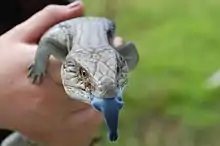Tiliqua scincoides
Tiliqua scincoides (common blue-tongued skink,[1] blue-tongued lizard, common bluetongue[2]) is a species of skink in the genus Tiliqua. It is native to Australia as well as to the Tanimbar and Babar Islands in the Maluku Province of Indonesia.[2]
| Tiliqua scincoides | |
|---|---|
 | |
| Scientific classification | |
| Kingdom: | Animalia |
| Phylum: | Chordata |
| Class: | Reptilia |
| Order: | Squamata |
| Family: | Scincidae |
| Genus: | Tiliqua |
| Species: | T. scincoides |
| Binomial name | |
| Tiliqua scincoides (White, 1790) | |
| Subspecies | |
|
3, see text | |
Subspecies
There are three subspecies:[2]
- Tiliqua scincoides scincoides – eastern blue-tongued skink (southern/eastern Australia)
- Tiliqua scincoides intermedia – northern blue-tongued skink (northern Australia)
- Tiliqua scincoides chimaera – Tanimbar blue-tongued skink (Maluku Province, Indonesia)
Description
This is a large terrestrial lizard measuring up to 60 centimetres long and 1 kilogram in mass. It has a stout body and short legs.[1] It is variable in color but generally has a banded pattern. The tongue is blue-violet[3] to cobalt blue in color.[4]
This lizard is diurnal, active during the day. It is omnivorous.[1] It is ovoviviparous, the eggs hatching inside the female's body; she then gives birth to 5 to 25 live young per litter.[3] This species is known to live over 30 years. It is an adaptable animal, often finding habitat in urban and suburban areas, including residential areas of Sydney.[1] The lizard is considered beneficial in these areas, with its appetite for garden pests such as slugs and snails.[3]
When threatened it may hiss and reveal its blue tongue, startling potential predators.[3]
There are three color-morphs that are part of the Tiliqua scincoides. The Albino T. scincoides, the Wild-type T. scincoides, and the Melanistic T. scincoides. In warm environments, the Wild-type T. scincoides and Melanistic T. scincoides have more reflective skin than the Albino T. scincoides, therefore these two lizards can warm their bodies at a faster rate.[5]
References
| Wikimedia Commons has media related to Tiliqua scincoides. |
- Koenig, Jennifer; Shine, Richard; Shea, Glenn (2002). "The dangers of life in the city: patterns of activity, injury and mortality in suburban lizards (Tiliqua scincoides)" (PDF). Journal of Herpetology. 36 (1): 62–68. doi:10.1670/0022-1511(2002)036[0062:TDOLIT]2.0.CO;2.
- Tiliqua scincoides at the Reptarium.cz Reptile Database. Accessed 18 May 2017.
- Tiliqua scincoides. Australian Reptile Online Database.
- Abbate, F.; Latella, G.; Montalbano, G.; Guerrera, M. C.; Germanà, G. P.; Levanti, M. B. (2009). "The lingual dorsal surface of the blue‐tongue skink (Tiliqua scincoides)". Anatomia, Histologia, Embryologia. 38 (5): 348–350. doi:10.1111/j.1439-0264.2009.00952.x. PMID 19769569. S2CID 24711884.
- Geen, Michael; Johnston, Gregory (July 2014). "Coloration Affects Heating and Cooling in Three Color Morphs of the Australian Bluetongue Lizard, Tiliqua Scincoides". Journal of Thermal Biology. 43: 54–60. doi:10.1016/j.jtherbio.2014.04.004. PMID 24956958.
